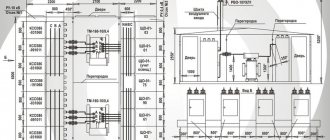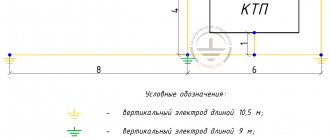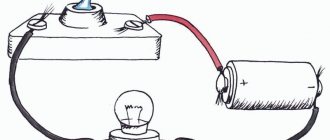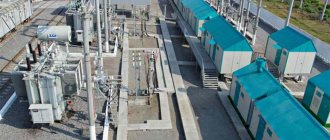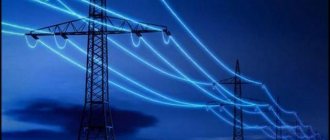NON-CURRENT CONDUCTING PART
NON-CURRENT CONDUCTING PART is a part of an electrical installation that is not energized during normal operation, but may become energized in emergency operating modes.
See what “NON-CURRENT CONDUCTING PART” is in other dictionaries:
non-current-carrying part - Part of an electrical installation that may be energized in emergency operating conditions, for example, the body of an electrical machine. [POT R M 016 2001] [RD 153 34.0 03.150 00] Topics: electrical safety ... Technical Translator's Guide
non-current-carrying part - 3.1.117 non-current-carrying part: Part of an electrical installation that may be energized in emergency operating modes, for example, the body of an electrical machine Source ... Dictionary of terms of normative and technical documentation
Non-current-carrying part - English: Inconductor Part of an electrical installation that may be energized in emergency operating conditions, for example, the body of an electrical machine (according to IPBEE) Source: Terms and definitions in the electrical power industry. Directory ... Construction Dictionary
part - 3.7 part: Part of the system under study. Note A part can be physical (for example, hardware) or logical (for example, a step in a sequence of operations). Source: GOST R 51901.11 2005: Risk management. Research... ... Dictionary-reference book of terms of normative and technical documentation
non-current carrying part - 2.6.2. non-live part: A conductive part of electrical equipment that can be touched directly, which is not normally live, but which may become live if damaged. Source... Dictionary-reference book of terms of normative and technical documentation
Non-current-carrying part - English: Inconductor A conductive part of electrical equipment accessible to direct touch, which is usually not energized, but may become energized in the event of damage (according to GOST 22789 94 ST IEC 439 1... ... Construction Dictionary
Exposed Conductive Part - 2.2.9 Exposed Conductive Part is a conductive part of electrical equipment that is accessible to touch and which is not normally live but may become live if damaged. Note Conductive part... ... Dictionary of terms of normative and technical documentation
OPEN CONDUCTIVE PART - a non-current-carrying part accessible to human touch, which may become energized if the insulation of live parts is broken ... Russian Encyclopedia of Occupational Safety and Health
GOST 28668-90: Low-voltage complete distribution and control devices. Part 1. Requirements for devices tested in whole or in part - Terminology GOST 28668 90: Low-voltage complete distribution and control devices. Part 1. Requirements for devices tested in whole or in part original document: 2.6.6. Emergency current: Current resulting from a breakdown or... ... Dictionary of terms of normative and technical documentation
Open conductive part - English: Outdoor conductor A non-current-carrying part accessible to human touch, which may become energized if the insulation of live parts is broken. Note. The non-current-carrying part means the current-carrying part... ... Construction Dictionary
Source
Grounding and protective measures for electrical safety, application terms and definitions
Which electrical installations are covered by Section 1 of the PUE?
Applies to all electrical installations of alternating and direct current with voltages up to 1 kV and higher and contains general requirements for their grounding and protection of people and animals from electric shock both during normal operation of the electrical installation and in the event of insulation damage.
How are electrical installations classified in relation to electrical safety measures?
Subdivided:
- For electrical installations with voltages above 1 kV in networks with a solidly grounded or effectively grounded neutral.
- Electrical installations with voltages above 1 kV in networks with an isolated or grounded neutral through an arc suppression reactor or resistor.
- Electrical installations with voltage up to 1 kV in networks with a solidly grounded neutral.
- Electrical installations with voltage up to 1 kV in networks with an insulated neutral.
What designations are accepted for electrical installations with voltage up to 1 kV?
The following notations are accepted:
- The TN system is a system in which the neutral of the power source is solidly grounded, and the open conductive parts of the electrical installation are connected to the solidly grounded neutral of the source through neutral protective conductors.
- TN-C system is a TN system in which the neutral protective and neutral working conductors are combined in one conductor along its entire length.
- TN-S system is a TN system in which the neutral protective and neutral working conductors are separated along its entire length.
- TN-CS system is a TN system in which the functions of the neutral protective and neutral working conductors are combined in one conductor in some part of it, starting from the power source.
- IT system is a system in which the neutral of the power supply is isolated from earth or grounded through high-resistance devices or devices, and the exposed conductive parts of the electrical installation are grounded.
- The TT system is a system in which the neutral of the power source is solidly grounded, and the exposed conductive parts of the electrical installation are grounded using a grounding device that is electrically independent from the solidly grounded neutral of the source.
How are the first letters in the designations of electrical installations deciphered?
The first letter indicates the state of the neutral of the power supply relative to ground. It is deciphered as follows: T-grounded neutral I-isolated neutral.
What is the meaning of the second letter?
The second letter indicates the state of the open conductive parts of the relative earth. T - the open conductive parts are grounded regardless of the relation to the ground of the neutral of the power source or any point of the supply network. N - the open conductive parts are connected to the solidly grounded neutral of the power source.
What do the letters after N mean?
They indicate the combination in one conductor or the separation of the functions of the zero working N and zero protective PE conductors. S - the zero working and zero protective conductors are separated. C - the functions of the zero protective and zero working conductors are combined in one conductor PEN - conductor.
Which electrical network is an effectively neutral-grounded network?
There is a three-phase electrical network with a voltage above 1 kV, in which the earth fault coefficient does not exceed 1.4.
What does the earth fault coefficient mean in a three-phase electrical network?
Denotes the ratio of the potential difference between the unfaulted phase and the earth at the point of an earth fault of another or two other phases to the potential difference between the phase and the earth at that point before the fault.
Which neutral is solidly grounded?
Is the neutral of a transformer or generator connected directly to the grounding device. The output of a single-phase alternating current source or the pole of a direct current source in two-wire networks, as well as the midpoint in three-wire DC networks, can also be solidly grounded.
Which neutral is insulated?
The neutral of a transformer or generator is not connected to a grounding device or is connected to it through a high resistance of signaling, measuring, protection and other similar devices.
What is the live part?
It is a conductive part of an electrical installation that is under operating voltage during its operation, including the neutral working conductor but not the PEN conductor.
What is an exposed conductive part?
This is a conductive part of an electrical installation that is accessible to touch and is not normally energized, but which may become energized if the main insulation is damaged.
What is a third party conductive part?
This is a conductive part and is not part of the electrical installation.
What is direct touch?
This is electrical contact of people or animals with live parts that are energized.
What is indirect touch?
This is electrical contact of people or animals with exposed conductive parts exposed to voltage when the insulation is damaged.
What protection is protection against direct contact?
This is protection to prevent touching live parts.
What protection is protection against indirect contact?
It provides protection against electric shock when touching exposed conductive parts that become energized when the insulation is damaged.
What is a ground electrode?
It is a conductive part or a set of interconnected conductive parts that are in electrical contact with the ground directly or through an intermediate conductive medium.
What is an artificial ground electrode?
This is a grounding conductor specifically designed for grounding purposes.
What is a natural grounding agent?
It is a third-party conductive part in electrical contact with the ground, directly or through an intermediate conductive medium, used for grounding purposes.
What is a grounding conductor?
This is a conductor connecting the grounded part to the ground electrode.
What is a zero potential zone?
This is the part of the earth that is outside the zone of influence of any ground electrode, the electric potential of which is assumed to be zero.
What is a spreading zone?
This is the earth zone between the ground electrode and the zero potential zone.
What is a ground fault?
There is accidental electrical contact between live parts and the ground.
What is meant by voltage on the grounding device?
Understand the voltage that occurs when current flows from the ground electrode into the ground between the point of current input into the ground electrode and the zero potential zone.
What is touch voltage?
This is the voltage between two conductive parts or between a conductive part and the ground when simultaneously touched by a person or animal.
What is step tension?
This is the voltage between two points on the surface of the earth at a distance of 1 m from one another, which is taken to be equal to the length of a person’s step.
How is the resistance of a grounding device determined?
It is defined as the ratio of the voltage on the grounding device to the current flowing from the ground electrode into the ground.
What is the equivalent resistivity of an earth with a heterogeneous structure?
This is the electrical resistivity of earth with a homogeneous structure, in which the resistance of the grounding device has the same value as in earth with a heterogeneous structure.
What is grounding?
It is an intentional electrical connection of any point in the network, electrical installation or equipment with a grounding device.
What is protective grounding?
This is grounding performed for electrical safety purposes.
What is working grounding?
It is the grounding of a point or points of live parts of an electrical installation, performed to ensure the operation of the electrical installation, not for the purpose of electrical safety.
What is protective grounding in electrical installations with voltages up to 1 kV?
It is a deliberate connection of open conductive parts with a solidly grounded neutral of a generator or transformer in three-phase current networks, with a solidly grounded output of a single-phase current source, performed for electrical safety purposes.
What is potential equalization?
This is an electrical connection of conductive parts to achieve equality of their potentials, and potential equalization performed for electrical safety purposes is called protective.
What is potential equalization?
This is a reduction in the step voltage potential difference on the surface of the earth or floor using protective conductors laid in the ground, in the floor or on their surface and connected to a grounding device, or by using special earth coverings.
What is the purpose of the PE protective conductor?
Designed for electrical safety:
- Protective earth conductor for protective earthing.
- Protective potential control conductor for protective potential control.
- Neutral protective conductor in electrical installations with voltages up to 1 kV for connecting open conductive parts to the solidly grounded neutral of the power source.
What is the neutral working neutral wire N intended for in electrical installations with voltages up to 1 kV?
Designed to power electrical receivers and connected to a solidly grounded neutral of a generator or transformer in three-phase current networks, to a solidly grounded terminal of a single-phase current source, to a solidly grounded source point in DC networks.
What is a combined neutral protective and zero working PEN conductors in electrical installations with voltages up to 1 kV?
This is a conductor that combines the functions of the zero protective and zero working conductors.
What is the main grounding bus of an electrical installation with voltage up to 1 kV intended for?
Designed for connecting several conductors for grounding and potential equalization. It is part of the grounding device.
What is the purpose of protective automatic power off?
Designed to automatically open the circuit of one or more phase conductors and, if required, the neutral working conductor for electrical safety purposes.
What is basic insulation?
This is the insulation of live parts, including protection from direct contact.
What is additional insulation?
This is independent insulation in electrical installations with voltages up to 1 kV, performed in addition to the main insulation for protection against indirect contact.
What is double insulation?
This is insulation in electrical installations with voltages up to 1 kV, consisting of basic and additional insulation.
What is reinforced insulation?
This is insulation in electrical installations with voltages up to 1 kV, providing a degree of protection against electric shock equivalent to double insulation.
What is ELV Extra Low Voltage?
This is a voltage not exceeding 50 V for AC and 120 V for DC.
What is an isolation transformer?
It is an isolation transformer, the primary winding of which is separated from the secondary windings using protective electrical separation of circuits.
What is a safety isolation transformer?
This is an isolation transformer designed to power circuits with ultra-low voltage.
What is a protective screen?
This is a conductive screen designed to separate an electrical circuit and conductors from live parts of other circuits.
What is protective electrical separation?
This is the separation of one electrical circuit from other circuits in electrical installations with voltages up to 1 kV using double insulation. Basic insulation and a protective screen. Reinforced insulation.
What rooms, zones, areas are non-conductive?
These are rooms, zones, areas in which protection from indirect contact is provided by the high resistance of the floor and walls and in which there are no grounded conductive parts.
For more detailed information, please contact our specialists by phone.
Live part (current-carrying part): what is it, definition, examples
Definition of the concept.
A live part is a conductive part intended to be live under normal conditions, including the neutral conductor and the middle conductor, but generally not a PEN conductor, PEM conductor, or PEL conductor (defined according to GOST 30331.1-2013). In regulatory documents, along with the term “live part,” the term “current-carrying part” is used. This does not necessarily imply a risk of electric shock.
Kharechko Yu.V. in his book [2], in my opinion, exhaustively supplements the definition:
“The term in question defines those conductive parts of electrical equipment and electrical installations that are energized when operated under normal conditions. The live part, being a special case of the conductive part, has one distinctive feature - it can be energized under normal conditions. Conductive parts which are not live under normal conditions but may become live under fault conditions are not live parts. »
Examples of live parts.
Live parts include phase and neutral conductors of alternating current electrical circuits, pole and middle conductors of direct current electrical circuits, as well as other conductive parts of a low-voltage electrical installation that have electrical connections with these conductors and are under normal conditions under an electrical potential different from earth potential.
Figure 1 shows the phase (L1, L2, L3) and neutral conductor N as an example of live parts.
Kharechko Yu.V. in his dictionary [2] explains why PE, PEN, PEM and PEL conductors are not classified as live parts:
“Protective conductors, including the protective earthing conductor and the protective equipotential bonding conductor, are not classified as live parts because under normal conditions they are at an electrical potential substantially equal to the earth potential. The PEN conductor is not considered a live part, although it functions as a neutral conductor. The PEM conductor is also not classified as a live part, although this conductor functions as a middle conductor. The PEL conductor is not considered a live part, even though the linear conductor it serves as the most typical example of a live part. »
Kharechko Yu.V. draws attention to the dangers that live parts may pose:
“Since the electrical potential of the live parts of the electrical installation of a building differs from the ground potential, which is practically equal to zero, and the conductive parts connected to the ground, they must be reliably insulated. Any contact by a person or animal with a live part that is more than Extra Low Voltage may result in electric shock. Such live parts pose a particular danger to humans. In regulatory and legal documentation they are called dangerous live parts. »
Source
Traction and transformer substations - Live parts
Page 6 of 52
Current-carrying parts include bare and insulated conductors designed to connect energy sources to energy receivers through various switching devices.
Busbars are uninsulated conductors of switchgear devices. Tires must have the necessary electrical conductivity and sufficient mechanical strength. The first requirement arises from the need to ensure low energy losses, the second is dictated by the need to ensure mechanical resistance to the action of forces arising during a short circuit (SC). Tires are copper, aluminum, steel. Copper busbars have low electrical resistivity and sufficient mechanical strength. They are used in powerful electrical installations with high currents. Aluminum has greater electrical resistivity and lower mechanical strength than copper. Steel tires have a high specific resistance, but in terms of mechanical strength they are superior to copper and aluminum. The tire material is selected taking into account the greatest savings in non-ferrous metals. For these reasons, it is advisable to use steel busbars for inflows up to 300-400 A. Copper busbars are used in exceptional cases (due to scarcity) with a sufficient feasibility study. Aluminum tires are most widely used. Rice. 9. Arrangement of tires in the vertical plane (a) and horizontal plane flat (b) and on the edge (c, d)
The cross-section of rigid tires can be rectangular or round. Rectangular tires cool better, especially with an aspect ratio of 1/5 - 1/10. Due to the larger cooling surface, the permissible current density for rectangular busbars is higher than for round busbars. Rectangular tires are made in the form of strips ranging in size from 15 x 3 to 120 x 10 mm. Round tires with solid or tubular cross-section have diameters from 6 to 100 mm. In switchgears with voltages of 35 kV and above, flexible busbars made of aluminum or steel-aluminum cable are widely used. In 35 kV switchgears, busbars made of aluminum pipes can be used, as they reduce corona.
Rigid rectangular busbars of switchgears with voltages up to 10 kV are installed in a vertical (Fig. 9, a), horizontal (Fig. 9, b and c) and inclined plane. Rectangular busbars are attached to insulators either on the edge (see Fig. 9, a and c), or flat (see Fig. 9, b). When laying these busbars flat, the permissible current load is reduced by 5-8% due to worsening cooling conditions. For large current values, buses of several strips are used (Fig. 9, d); the strips are secured in a package with a distance d between them not less than their thickness, h is the height of the strip. The permissible current for a package of strips is not proportional to the number of strips, but is somewhat reduced due to their worse cooling and the influence of the magnetic field of neighboring strips. Cables are current conductors insulated from each other and from the ground with paper, plastic or rubber insulation and placed in a lead, aluminum, polyvinyl chloride or rubber sheath. The shell serves as waterproofing for the cores. In order to protect the waterproofing sheath from mechanical damage, the cable is covered with armor. The armor is covered with an asphalted rope. There are power cables and communication cables. Power cables are used for electrical connections of equipment and equipment with each other and with the buses of switchgear, as well as for lines connecting individual electrical installations. Cables are characterized by design, number and cross-section of cores, as well as voltage. The cable design is usually denoted in capital letters. Meaning of letters or combinations of letters: A - aluminum core; AC - aluminum core and lead sheath; AA - aluminum core and aluminum sheath; B - armor made of two steel strips with an anti-corrosion protective coating; BN - the same, but with a non-flammable protective cover (does not support combustion); G - absence of protective covers over the shell armor; P (K) - armor made of galvanized flat (round) wires, on top of which a protective cover is applied. Power cables are manufactured as single-, three- and four-core for standard voltages from 1 to 35 kV, with sections corresponding to standard wire sections 2.5; 4; 6; 10 ;16; 25; 35; 50; 70; 95; 120; 150; 185; 240; 300; 400; 500; 625 and 800 mm2. The fourth core of a four-core cable, which serves as a neutral wire, has a cross-section two times smaller than each of the phase wires. The full designation of a power cable includes: cable design - in capital letters, number of cores and cross-section of one core, rated voltage in kV. For example, ASB-3 X 95-10 means: a cable with aluminum current-carrying conductors, a lead waterproofing sheath, armored with an anti-corrosion protective coating, three-core, cross-section 95 mm2 each, rated voltage 10 kV; ASBG-3 X 95-10 - cable with aluminum current-carrying conductors, lead waterproofing sheath, armored without protective cover, three-core, cross-section 95 mm2 each, rated voltage 10 kV.
Communication cables are manufactured with a number of cores from 4 to 37 (4, 5, 7, 10, 14, 19, 27 and 37) with a cross-section of each core from 1 to 10 mm2 according to the standard. Communication cables are used for control, automation, signaling and protection circuits, therefore they are manufactured for voltages up to 1 kV (0.66 kV). Cable cores are in most cases used with rubber and polyethylene insulation. Cables with such core insulation are very convenient for installation. For ease of checking circuits during installation and operation, cable cores are insulated with colored insulating materials. Communication cables are similar in design and markings to power cables. The full designation of a communication cable includes the cable design (in capital letters), the number of cores and the cross-section of one core. The voltage is not indicated, since communication cables are manufactured for voltages up to 1 kV.
- Back
- Forward
What is the current-carrying and non-current-carrying part of the power plant?
How is a voltmeter connected to an electrical circuit?
Tension – we come across this term quite often in everyday life. Sometimes we need to measure the voltage in the network to understand why a device is not working satisfactorily or an incandescent lamp is burning rather dimly. For this type of measurement, voltmeters are used. A voltmeter is connected to the device being measured only in parallel , why is this so? As you know, electric voltage is the ratio of the work done by the electric field to move charge A to the amount of charge q, U=A/q. It also characterizes the electric field that occurs when an electric current passes.
Non-current carrying part
See what “non-current carrying part” is in other dictionaries:
non-current carrying part - 2.6.2. non-live part: A conductive part of electrical equipment that can be touched directly, which is not normally live, but which may become live if damaged. Source... Dictionary-reference book of terms of normative and technical documentation
NON-CURRENT CONDUCTING PART is a part of an electrical installation that is not energized during normal operation, but may become energized in emergency operating modes... Russian Encyclopedia of Occupational Safety and Health
non-current-carrying part - Part of an electrical installation that may be energized in emergency operating conditions, for example, the body of an electrical machine. [POT R M 016 2001] [RD 153 34.0 03.150 00] Topics: electrical safety ... Technical Translator's Guide
part - 3.7 part: Part of the system under study. Note A part can be physical (for example, hardware) or logical (for example, a step in a sequence of operations). Source: GOST R 51901.11 2005: Risk management. Research... ... Dictionary-reference book of terms of normative and technical documentation
non-current-carrying part - 3.1.117 non-current-carrying part: Part of an electrical installation that may be energized in emergency operating modes, for example, the body of an electrical machine Source ... Dictionary of terms of normative and technical documentation
Non-current-carrying part - English: Inconductor Part of an electrical installation that may be energized in emergency operating conditions, for example, the body of an electrical machine (according to IPBEE) Source: Terms and definitions in the electrical power industry. Directory ... Construction Dictionary
Exposed Conductive Part - 2.2.9 Exposed Conductive Part is a conductive part of electrical equipment that is accessible to touch and which is not normally live but may become live if damaged. Note Conductive part... ... Dictionary of terms of normative and technical documentation
GOST 28668-90: Low-voltage complete distribution and control devices. Part 1. Requirements for devices tested in whole or in part - Terminology GOST 28668 90: Low-voltage complete distribution and control devices. Part 1. Requirements for devices tested in whole or in part original document: 2.6.6. Emergency current: Current resulting from a breakdown or... ... Dictionary of terms of normative and technical documentation
Open conductive part - English: Outdoor conductor A non-current-carrying part accessible to human touch, which may become energized if the insulation of live parts is broken. Note. The non-current-carrying part means the current-carrying part... ... Construction Dictionary
OPEN CONDUCTIVE PART - a non-current-carrying part accessible to human touch, which may become energized if the insulation of live parts is broken ... Russian Encyclopedia of Occupational Safety and Health
Source
Basic terms used in articles about RCDs
In this article, I will formulate the basic terms used in articles about RCDs and are needed to understand the content of the articles and understand those elements of the electrical network that are discussed in the articles on the site.
Electrical installation
Electrical installation – any set of devices, electrical lines and circuits, auxiliary equipment used for the distribution, consumption and/or conversion of electrical energy.
For site articles. About the RCD, it is important to understand that the concept of electrical installation means a residential building with all electrical wiring and electrical devices, a separate apartment, with its own group electrical wiring circuits, distribution devices (ASU, VU, distribution panels, apartment and floor panels) and electrical energy consumption ( included household appliances and/or engines in private homes).
Live part
A live part is a part of an electrical installation that is under operating voltage during operation. Working wires, electrical cables, busbars in distribution boards are current-carrying parts of an electrical installation.
Exposed conductive part
An open conductive part is a part of an electrical installation (consumer) that, due to its manufacturing material, can conduct electric current, but in operating mode it is isolated from the current. An open conductive part is a potentially dangerous part of an electrical installation for humans in emergency situations when the insulation of live parts is damaged and current leaks into it.
Fault current
Fault current is a current that appears in a circuit when the insulation of live parts of an electrical installation is damaged.
Supercurrent
Overcurrent is any current in an electrical circuit that exceeds the operating current value. Overcurrent is a short circuit current in a circuit and an overload current.
Overload current
Overload current is an overcurrent of an electrical circuit that occurs in a circuit without damage to the insulation of live parts. An overload current occurs when a power exceeding the rated power is connected to an electrical installation circuit.
Leakage current
Leakage current is an electric current flowing from an electrical installation to the ground or to conductive parts of third-party electrical installations. However, the electrical network is clearly not damaged.
Short circuit currents
Short circuit currents are divided into earth fault currents, phase and zero fault currents, and fault currents of two different phases. In articles about RCDs, there is often a ground fault current, that is, a current that passes into the ground through the fault point of the phase wire.
Touch voltage
Touch voltage is the voltage on the human body when it simultaneously touches two points of conductive parts or working conductors of a circuit, including insulation damage.
Residual current device
A residual current device , or RCD for short, is a switching device controlled by a differential current arising in a toroidal sensor. When a certain value of the differential current is reached, the contacts open and the power circuit breaks.
Differential current
The differential current is the vector sum of the currents flowing in the primary circuit of the RCD, the current electrical network.
Rated breaking current of RCD
The rated breaking current of the RCD is the differential breaking current of the RCD, specified by the factory at which the RCD is triggered (switched off).
RCD current
The rated current of the RCD is the current value specified by the manufacturer that the RCD can pass for an unlimited period of time in the operating mode.
Protection against indirect contact
Protection against indirect contact is the protection of exposed conductive parts from possible contact with them in the event of a circuit failure.
Potential equalization
Potential equalization is the elimination of the electrical potential difference between all open conductive parts that are simultaneously accessible to touch. Potential equalization is achieved by connecting the conductive parts of an electrical installation with electrical conductors.
Electrical potential equalization
Potential equalization is the reduction of the electrical potential difference between the grounding device, exposed conductive parts and the ground surface.
These are all the basic terms for RCDs. ©Elesant.ru
What is the current-carrying and non-current-carrying part of the power plant?
Live part - part of an electrical installation that is normally energized
Non-current-carrying part - a part of an electrical installation that may be energized in emergency operating conditions, for example, the body of an electrical machine
How is a voltmeter connected to an electrical circuit?
Tension – we come across this term quite often in everyday life. Sometimes we need to measure the voltage in the network to understand why a device is not working satisfactorily or an incandescent lamp is burning rather dimly. For this type of measurement, voltmeters are used. A voltmeter is connected to the device being measured only in parallel , why is this so? As you know, electric voltage is the ratio of the work done by the electric field to move charge A to the amount of charge q, U=A/q. It also characterizes the electric field that occurs when an electric current passes.
In the international notation system, SI is designated as U and is measured in volts (1 V = 1 J/C). In order to measure the voltage on the device, you need to connect a voltmeter in parallel to it.
What are your actions when a personal anal gas analyzer is triggered by one of the team members at the workplace?
1. Wear your MiniSCAPE™ emergency respirator
Stop work
Determine the wind direction
Leave the polluted area, moving perpendicular to the direction of the wind, then against the wind to the PS
1.2. Personnel requirements
Question 65. What are the requirements of the Rules for the professional training of workers accepted to perform work in electrical installations?
Answer. Must have professional training appropriate to the nature of the work. In the absence of professional training, they must be trained (before being allowed to work independently) in specialized personnel training centers (training centers, educational training centers, etc.).
Question 66. During what periods are workers’ health checked?
Answer. It is carried out before the employee is hired, and also periodically in the manner prescribed by the Russian Ministry of Health.
Question 67. What should electrical personnel be trained in addition to professional training?
Answer. Before being allowed to work independently, he must be trained in how to free a victim from the effects of electric current and provide first aid in case of accidents.
Question 68. By what standards and rules must electrical engineering (electrotechnological) personnel undergo a knowledge test?
Answer. Must pass a knowledge test of these Rules and other normative and technical documentation (PTEEP, PPB, PPISZ, PUE) within the requirements for the relevant position or profession, and have the appropriate electrical safety group.
Question 69. Which document reflects the employee’s right to carry out special work?
Answer. It is reflected in the certificate after testing the employee’s knowledge of the rules and regulations for working in electrical installations.
Question 70. What work is classified as special?
Answer. The following works include:
steeplejacks;
under voltage on live parts: cleaning, washing and replacing insulators, repairing wires, monitoring insulators and connecting clamps with a measuring rod, lubricating cables;
testing equipment with increased voltage (except for work with a megohmmeter).
Question 71. How is permission to work independently obtained?
Answer. An employee undergoing an internship or duplication must be assigned by order to an experienced employee. Permission to work independently must be issued by a corresponding order from the head of the organization.
